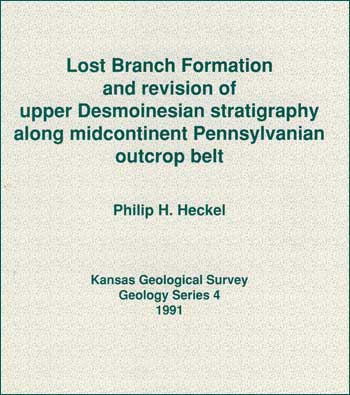Lost Branch Formation and revision of upper Desmoinesian stratigraphy along midcontinent Pennsylvanian outcrop belt
by Philip H. Heckel
University of Iowa and Kansas Geological Survey

Originally published in 1991 as Kansas Geological Survey Geology Series 4.
A PDF version is available
Abstract
The name Lost Branch Formation is proposed for a thin but widespread sequence of gray to black marine shales with thin limestones that lies upon a subaerial exposure surface developed upon terrestrial deposits and lies beneath another sequence of terrestrial deposits. The name Memorial Shale is revised to apply to the underlying sequence of blocky mudstone, shale, sandstone, and coal (Dawson coal) that overlies (and partly interfingers with) the marine Lenapah Limestone. The Lost Branch Formation can be traced in both cores and wire-line logs for several hundred miles along the midcontinent Pennsylvanian outcrop belt and into the subsurface. It ranges from a few feet thick in Iowa and Nebraska through 15 ft (4.5 m) thick in Missouri and Kansas to at least 65 ft (20 m) thick in east-central Oklahoma. It includes the following previously named units: Cooper Creek Limestone Member, named in Iowa; Sni Mills Limestone Member, named in Missouri; and Homer School limestone bed, Nuyaka Creek black shale bed, and Glenpool limestone bed, all named in Oklahoma. Recognition of the Lost Branch Formation as a single widespread marine horizon helps to correct long-standing miscorrelations of strata across the Desmoinesian-Missourian Stage boundary, as it includes strata of Desmoinesian age previously assigned to the Desmoinesian Lenapah Limestone and Holdenville Shale and the Missourian Seminole Formation and Hertha Limestone. A distinctive fauna of conodonts and ammonoids allows biostratigraphic correlation of the Lost Branch Formation along the entire midcontinent outcrop belt into the upper part of the type Holdenville Shale of east-central Oklahoma. The conodonts also allow correlation with the Lonsdale and West Franklin Limestone Members of Illinois. The highest occurrences in the Lost Branch Formation of certain genera and species of conodonts, ammonoids, brachiopods, and fusulinids, which are characteristic of underlying Desmoinesian rocks, in conjunction with the highest occurrences of characteristically Desmoinesian lycospore-dominated palynomorph floras in the underlying coals strongly suggest that the best current placement of the Desmoinesian-Missourian Stage boundary (and thus the Middle Pennsylvanian-Upper Pennsylvanian Series boundary) is at (or above) the top of the Lost Branch Formation. This boundary, which is at its traditional position in Kansas, Missouri, and Iowa, is marked by an upward transition from marine to terrestrial deposits with widespread subaerial exposure. Although it may thus be disconformable in places, it is not an unconformity of the stratigraphic magnitude previously believed, which was based on the miscorrelations. Depositionally, the Lost Branch Formation represents a single widespread inundation and withdrawal of the sea over the broad northern midcontinent shelf following the upper Memorial regression, which terminated the earlier, less widespread Lenapah inundations. The Lost Branch differs from the other widespread but limestone-dominated marine formations in the midcontinent Pennsylvanian by having only thin local developments of limestone. This difference probably resulted from a greater rate of transgression and regression for the Lost Branch inundation and consequent shorter periods of time during which the sea bottom remained within the appropriately shallow sunlit water depths favorable for carbonate production. The greater than usual marine withdrawal from the shelf that terminated Lost Branch deposition may have been responsible for the post-Desmoinesian extinctions in both biotic realms, both by crowding the marine organisms into small cratonic basins and by eliminating the broad freshwater swamp environments of the arborescent lycopods from the emergent shelves.
Kansas Geological Survey, Geology
Placed on web Nov. 2, 2010; originally published 1991.
Comments to webadmin@kgs.ku.edu
The URL for this page is http://www.kgs.ku.edu/Publications/Bulletins/GS4/index.html